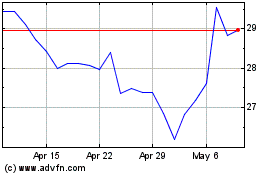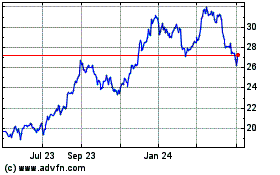Oil Prices Trade Lower in London
May 27 2016 - 6:30AM
Dow Jones News
LONDON—Oil prices traded back below the key $50 threshold on
Friday, as investors took profits from the recent rally and the
dollar strengthened.
Brent crude, the global oil benchmark, fell 1.2% to $49.57 a
barrel on London's ICE Futures exchange. On the New York Mercantile
Exchange, West Texas Intermediate futures were trading down 1% at
$49.02 a barrel.
Oil breached $50 a barrel on Thursday for the first time since
November. Analysts are now asking whether Friday's fall is just a
temporary pullback or is indicative of a market which still faces a
problem with oversupply.
"Speculators are clearly very cautious at these price levels,"
said David Hufton of PVM brokerage, adding that some Canadian
production might return after outages due to wildfires. "Then there
is dollar strength to consider with a Federal Reserve hike in June
back on the table."
The Wall Street Journal Dollar Index, which tracks the greenback
against a basket of other currencies, rose 0.1% on Friday. As oil
is priced in dollars, it becomes more expensive for holders of
other currencies as the greenback appreciates.
Oil prices have bounced back from the decade-lows of below $30
that they hit earlier this year. The rally has been fueled by a
combination of supply disruptions and a continued fall in U.S. oil
output.
Despite the recent retreat, U.S. crude is still up nearly 90%
from its 13-year low in February, the sharpest rise since an
increase of 92% between February and May of 2009.
Still, some analysts say disruptions are mostly temporary,
meaning that many of the lost barrels will be back.
"Expecting a persisting supply glut and fearing the excessively
bullish sentiment we see more downside than upside from today's
prices and maintain our cautious view," said Norbert Rü cker, head
of commodities research at Julius Baer.
Production by members of the Organization of the Petroleum
Exporting Countries is also on the rise. UBS analysts forecast that
OPEC's production will exceed 33 million barrels a day this
summer.
In a meeting in Doha in mid-April, a group of OPEC and non-OPEC
members, including heavyweights Saudi Arabia and Russia, failed to
agree on a production cap. The next OPEC meeting is scheduled for
June 2 in Vienna.
"We don't expect OPEC producers to come to any agreement at the
coming meeting in Vienna and expect Gulf countries to ramp up
production," UBS said in a report. "This return of disrupted supply
and OPEC's increasing of production lay the foundation for a wider
market surplus, and for prices to fall back below $40 in the short
run."
Later in the day, traders will also look to the latest U.S. oil
rig count, which is a rough proxy for activity in the industry.
Last week, Baker Hughes Inc., which tracks the data, said the
number of rigs drilling for oil was unchanged at 318. There are
still around 70% fewer rigs, from a peak of 1,609 in October
2014.
Another concern for more bearish analysts is whether oil had now
reached levels that make drilling economical for firms who have
pulled rigs. This would in turn threaten the price recovery, they
say.
"The weekly oil rig count from Baker Hughes will be followed
closely…and another big question of the day is if the trend is
about to reverse as oil prices have regained some strength over the
last months," said Michael Poulsen, oil analyst at Global Risk
Management.
Nymex reformulated gasoline blendstock—the benchmark gasoline
contract—fell 0.6% to $1.62 a gallon. ICE gasoil changed hands at
$441 a metric ton, down $7.25 from the previous settlement.
Jenny W. Hsu contributed to this article
Write to Georgi Kantchev at georgi.kantchev@wsj.com
(END) Dow Jones Newswires
May 27, 2016 06:15 ET (10:15 GMT)
Copyright (c) 2016 Dow Jones & Company, Inc.
UBS (NYSE:UBS)
Historical Stock Chart
From Mar 2024 to Apr 2024

UBS (NYSE:UBS)
Historical Stock Chart
From Apr 2023 to Apr 2024
